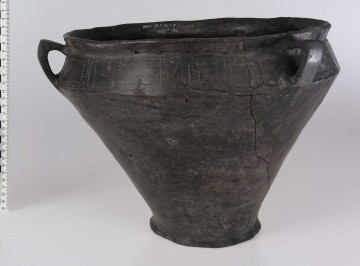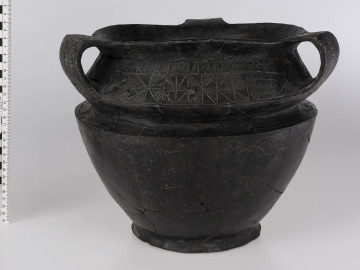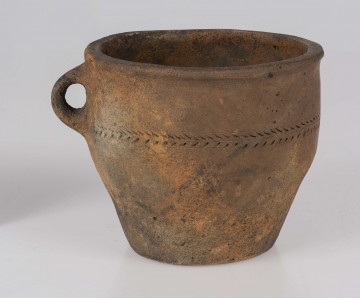
Vessel
National Museum in Lublin
Part of the collection: Set of archaeological relics found in the Lublin Region
A richly decorated vessel made by hand from clay, burnt brown, was found in the cemetery of the Przeworsk culture in Opoka (Końskowola commune, the Puławy poviat, the Lublin Voivodeship). Archaeological research on the site was conducted in 1961-1962 by Zygmunt Ślusarski.
Typologically, the vessel can be described as a sharply profiled jug with a straight, outwardly bending rim, emphasised by a groove, sharply marked bend of the body and a separate foot. The ear is ribbon-shaped, elbow-shaped bent. It is distinguished by the fact that from the knee-shaped bend of the ear a channel has been drilled inside the jug. Above the bend of the bowl, the vessel is decorated with a blank ornament, which consists of a pair of parallel engraved lines filled with holes. The whole is situated between the thread of the engraved line and the row of holes. The canal may have facilitated drinking from the jug.
A small jug was used as an ashtray (urn) in one of the corporeal graves in a birch burial site located in the Kurówka River valley with almost a hundred burials. The Vandals (representatives of the Przeworsk culture) often used richly decorated vessels with a carefully finished external surface as ashtrays in their cemeteries.
The ceramics reflect the local cultural diversity. This means that in certain regions of a culture, at a certain time, there was a "fashion" for certain types of vessels and ornaments. Jugs with ear with a canal are known especially from the area between Vistula and San. They date from the 2nd half of the 2nd century AD.
Author / creator
Dimensions
cały obiekt: height: 171 mm
Object type
dish
Technique
firing
Material
clay
Creation / finding place
Owner
The National Museum in Lublin
Identification number
Location / status

National Museum in Lublin

National Museum in Lublin

National Museum in Lublin
DISCOVER this TOPIC
National Museum in Lublin
DISCOVER this PATH
Educational path